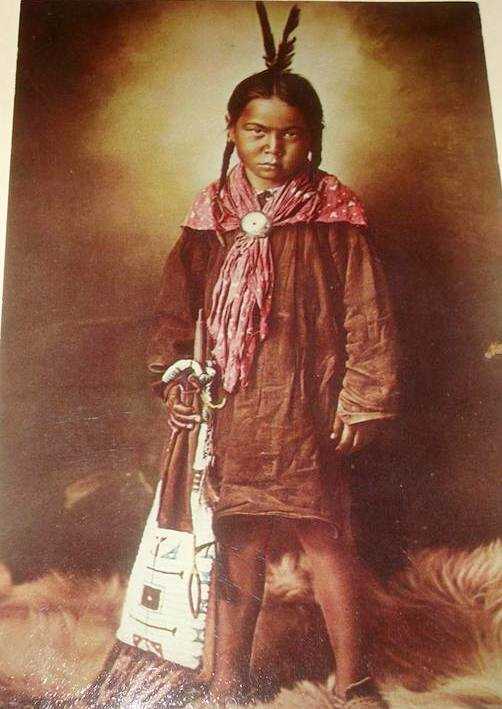
The Plains Tribes: The Cheyenne

Figure 1.--"Little Cheyenne Bearing Pipe" is the title of this portrait of a defiant little Cheyenne boy. The portrait was taken by frontier photographer L.A. Huffman (1854-1951). He set up a studio in Miles City, Montana Territory.
He was the post photographer at Fort Keogh, Montana Territory. Huffman is one of the most important photographers of the Old west. He photographed the Plains Indians (especially the Northern Cheyenne and Sioux), Cowboys, Ranches, etc in early Montana in The Miles City, Montana area in Eastern Montana. The Northern Cheyenne Indians used to stop in Huffman's Studio at the fort and he talked this young Cheyenne boy to sit so Huffman could take his photo. We portrait was probably taken during the 1880s. This hand-colored portrait was made from a glasss plate.
|
|
The Cheyenne people originsated east of the Mississippi in the wooded head waters of the Mississppi. The French explorer La Salle is the first European to mention thecCheyenne which he called Chaa--his spelling of the Sioux name for the Cheyenne (1680). He encountered them in what is now Illinois. They lived in permanent villages and engaged in agriculture. They began moving west and southwest, pushed by the tribes beung driven west by the English settlers. Eventually the Cheyenne moved into the Great Plains east of the Rockey Mountains. They are one of the most widely known of the Plains tribes. The Cheyenne Nation comprised ten bands, spread over the Great Plains, from southern Colorado to the Black Hills in South Dakota. The Sioux in the mid-19th century began to divide. Some bands remained near the Black Hills, while others tended to keep close to Platte River of central Colorado. In this process they split into two groups, the northern and southern Sioux. Their easterly origins is conformed by their languge. The Cheyenne speak a dialect belongs to the Algonquin language family. The alphabet consists of only fourteen letters.
As the Cheyenne moved west on to the Plains, their culture changed from a settle agricultural existence to a more nomadic hunting society. The men capture wild horses which descended from animals that escaped from the Spanish. This helped them hunt bufalo. They also traped beaver.
An important custom shared with orther Algonquin people was the smoking of the peace pipe. There was a some very carefully followed process involving the smoking of the pipe. A prayer was offered before the pipe was lit. Braves often had their own way to smoke the pipe. Another important Cheyenne tradition was story telling.
CIH

Navigate the Children in History Website:
[About Us]
[Introduction]
[Biographies]
[Chronology]
[Climatology]
[Clothing]
[Disease and Health]
[Economics]
[Freedom]
[Geography]
[History]
[Human Nature]
[Ideology]
[Law]
[Nationalism]
[Presidents]
[Religion]
[Royalty]
[Science]
[Social Class]
[Bibliographies]
[Contributions]
[FAQs]
[Glossaries]
[Images]
[Links]
[Registration]
[Tools]
[Children in History Home]
Navigate the CIH ethnic pages:
[Return to the Main Plains Tribes page]
[Return to the Main ethnic page]
[German]
[Greek]
[Irish]
[Scottish]
Navigate the Boys' Historical Clothing Native American pages:
[Return to the Main Native American cultural area page]
[Return to the Main Native American ethnic page]
[Return to the Main Native American page]
[Ethnic]
[Dance]
Created: 5:22 AM 8/24/2008
Last updated: 5:16 AM 10/31/2011



